
Pebble Control is a new self-contained, scalable, configurable IP connection management system built specifically to help broadcasters who are aiming to change over to an all IP facility without having to deploy a bespoke enterprise system.
Pebble Control operates on web-based UIs, with full support for the NMOS (Networked Media Open Specifications) suite of protocols produced by the Advanced Media Workflow Association (AMWA) to facilitate networked media for professional applications. It interfaces with NMOS-enabled devices from multiple vendors on the network. It can be reconfigured when interconnections change or when devices are added or removed, resulting in plug and play functionality for IP networks.
Pebble’s expertise in automation, which started with linear channels, has now evolved to focus on modern network devices. The emphasis is on interoperability rather than size or complexity of the system -- Pebble Control can run on one or many physical or virtual machines, networked machines or on Pebble’s Ocean system that runs on containers using Kubernetes. The background database is also scalable, starting with simple camera-and-monitor test systems and going on to handle hundreds of devices.
SMPTE and NMOS Standards
“SMPTE ST 2110 has been a game-changer for the rollout of uncompressed IP networks in broadcast and is invaluable for the way it specifies how to transport and synchronise video, audio, and ancillary data. But it doesn’t cover how devices on a network can be discovered or connected, which is why the NMOS suite is important,” said Miroslav Jeras, Pebble’s CTO.

Pebble Control tabular interface for provisioning multicast settings.
“We are seeing an increasing amount of proprietary approaches in the market, but the goal must be to make interoperability simpler rather than putting barriers in the way. For this reason, NMOS and Pebble Control can be very helpful for broadcasters looking to establish IP native workflows.”
Pebble Control includes automatic discovery and resource management fully supporting the NMOS IS-04 v1.3 specfication for device Discovery and Registration. Physical and logical views visualise the environment for users, making organising an IP system simpler and helping broadcasters make workflows as productive as possible for their particular applications. Immediate feedback from the NMOS registry informs users when critical devices go offline.
Users work through a responsive tabular interface to provision the multicast settings for NMOS senders. The ability to export and import configuration data allows users to delegate and quickly restore settings.
Full support for the NMOS IS-05 v1.1 specification for device Connection Management, as well as the flexibility of defining custom logical views and containers, makes connection straightforward and as familiar as connecting SDI signals.
Workflow and Facility Integration
By emulating legacy index-based matrices or routers, any I/O or container can be connected using the established SW-P-08 protocol. The SW-P-08 General Remote protocol has been used by many router and controller designers to allow their equipment to control or be controlled by other manufacturers’ equipment. Input sources and output destinations are assigned unique SW-P-08 ID’s within the router, which are mapped and labelled the same way in the controller.

Software panels compatible with NMOS IS-07 and third-party NMOS IS-07 hardware panels can be integrated to perform actions and display critical information. Pebble Connect’s own software panel has configurable functionality and gives quick access to the main features.
Authentication and granular authorisation can be set through attribute-based workflows, controlling user access is as required. Deployment and host management options are flexible due to Pebble Connect’s ability to run standalone, as a redundant pair or distributed. The UI for configuration is comprehensive so that users can scale it to an exact size for specific operations.
Pebble is making online help and a series of tutorial videos available for the new system to help put IP routing and switching within reach of most broadcasters looking to transition to IP. “The transition to IP is gathering pace, but broadcasters establishing all-IP workflows may still encounter numerous pitfalls,” said Jeras. “Pebble Control removes the uncertainty of connections and, by using the interoperability of the NMOS suite of open standard protocols, makes uncompressed IP deployments quicker and simpler than they have been previously.” www.pebble.tv




